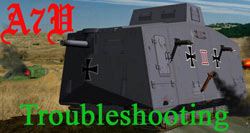last change: 27.03.2001
since 16.9.2000

Why the heck is there a tank ?!?
Main Page
"HowTo" Guides
Troubleshooting Guides
BIOS related information
CPU related information
Overclocking
Articles
Downloads
Forum
Contact
Links
|
CeBit 2001 - Meeting ASUS Tech Support
|
|
I still doubted it, but they do exist : ASUS German Tech Support was at CeBit 2001. When I stopped by at the ASUS booth in hall 13, eventually I talked to Thomas Ebel, responsible for ASUS AMD Mainboard Tech Support in Germany. When he found out that I am the webmaster of this site, he invited me to have a little talk about the A7V. Here are my questions and his answers () : Q: How can I reach tech support in Germany ? Q: Why is Tech Support virtually unreachable ? Q: What about the CRC problems with big files transferred between two harddisks on the ATA100 promise controller? Q: How come the new BIOS revisions are always available first at the German site? Q: Why is there no (or very little) information available on what the BETA BIOSes fix ? Q: But how can one determine if a new BIOS release fixes problems one is having? Q: What about that corrupt 1006 "killer" version ? Q: Why was "idling" disabled from 1004 on ? Q: Are you aware of the modified BIOSes ? Example : people at Brasiliantech disassemble the BIOSes and change register settings Q: What type of BIOS is used, anyway? AWARD 6.0 as the BIOS itself claims or some Phoenix-Award mixture? This is because most Utilities like modbin don't work for the A7V. Q: How are the temperature probe readings altered through the BIOS ? Q: Are there any tips on correct driver installation and where to put what kind of expansion card ? Q: Which 4-in-1 drivers should I use ? I hope I remembered everything correctly. By the way, thanks to Thomas for the very informative talk ! The best thing about this meeting is that I now have the possibility to contact the appropriate support directly. No - I won't give out the e-mail address or the phone number, but I will collect and forward questions that arise in the forum. |
|
CeBit 2001 - Meeting AMD
|
|
I also had the chance to talk to the person responsible for testing heatsinks and power supplies at AMD Germany. Q: How should one measure the CPU temperature? Q: What Temperatures are OK ? Q: Should I use thermal grease or a heat transfer pad ? Q: What Power Supply should be used? Q: But what power ratings are OK ? |